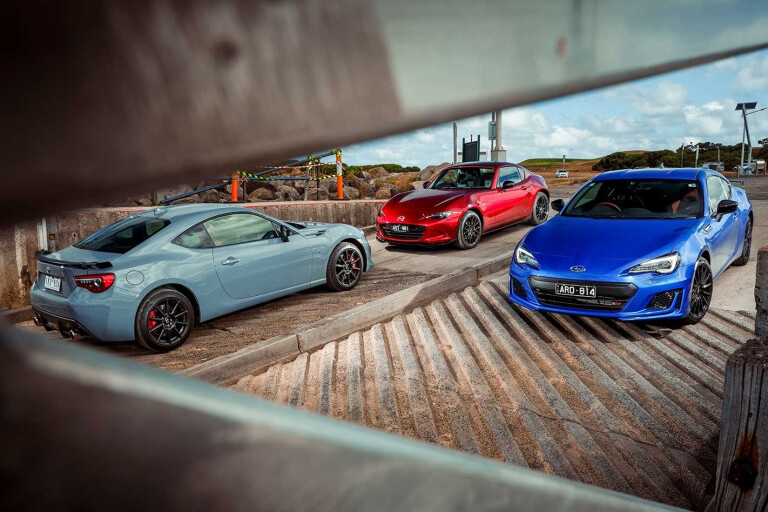
When the Subaru BRZ and Toyota 86 finished poorly at Bang For Your Bucks 2012, the postman got a hernia bringing in the mailbag for MOTOR that month.
As rear-drive, lightweight, keenly priced coupes, they were expected to – frankly – break our Bang For Your Bucks formula. But they didn’t. And people were unhappy.
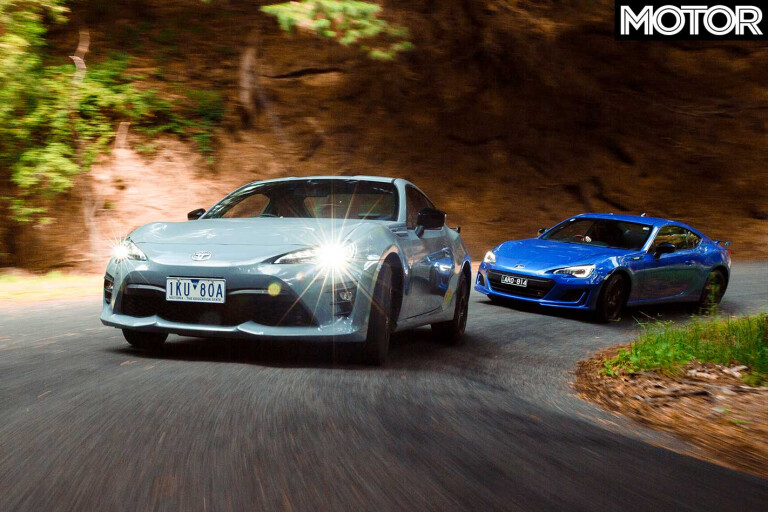
That’s because Bang For Your Bucks is a measure mostly of raw performance and, well, the 86 and BRZ aren’t about numbers, and the judges’ comments reflected as much, the Japanese pair locking out the top two results in the subjective rankings. Basically, the marketing spin was true – both the 86 and BRZ were absolutely brilliant.
As we are knuckle-draggers of the highest order, it wasn’t long before someone piped up with ‘those questions’, namely, could they use a cheeky turbo, or just a dash more grip?
We’ve watched Subaru and Toyota struggle to modify their masterpieces for years while these queries gnawed at our minds. Toyota teased us in 2013 with a Tada-tuned prototype that never made it to showrooms. It was followed by a sticker pack in 2015, a thorough fine-tune in 2016, then a TRD version that missed the mark in 2017.
Subaru’s efforts have been just as disappointing, with no more than a short-shifter or special colour headlining its special editions.
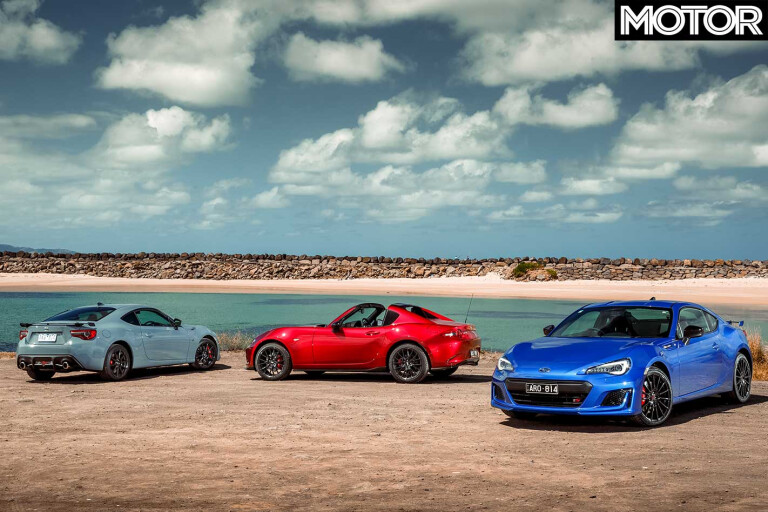
Recently, however, the car gods heeded our prayers – sort of. Subaru and Toyota announced proper factory-tuned bits the sports twins, making them the slightly-more-real deal.
While a model with a meaningful power increase remains the stuff of fantasy, we absolutely welcome the addition of words such as “Brembo” and “Sachs dampers” in official BRZ- and 86-related Subaru and Toyota press releases.
Shared across both cars, the new Brembo package comprises 326mm front discs clamped by four-piston calipers and rear two-piston calipers that gnaw 316mm ventilated discs.
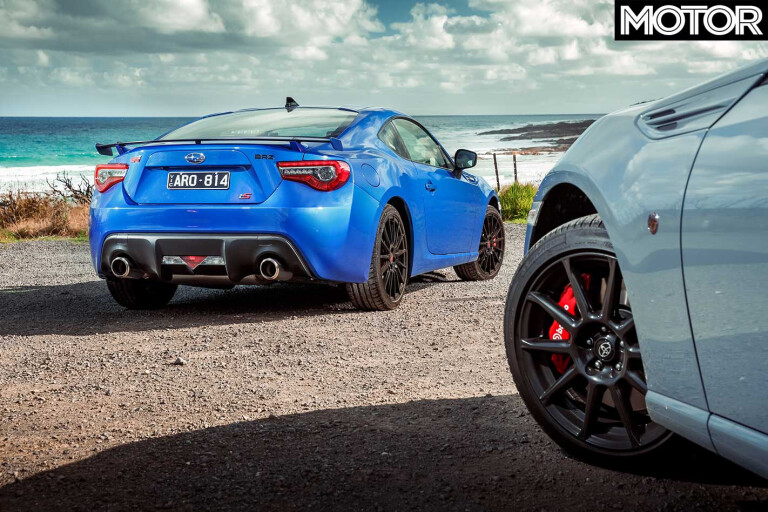
Toyota cages the brakes with sexier charcoal 17-inch wheels. They’re wrapped by the same 215/45 Michelin Primacy HP tyres used on the base car. You can find all this in a $2200 box on the 86 GTS’s options list (or $2900 for GT) which allows access to the exclusive Moon Slate grey as featured on our test vehicle here.
Subaru, meanwhile, infuses the new bits into a top-of-the-line BRZ called the tS. Short for ‘Tuned by STI’, the badge isn’t just a name. Fuji’s boffins have tinkered with the car’s chassis, bracing its belly and engine bay with bars to complement lowering springs coiled around its Sachs dampers.
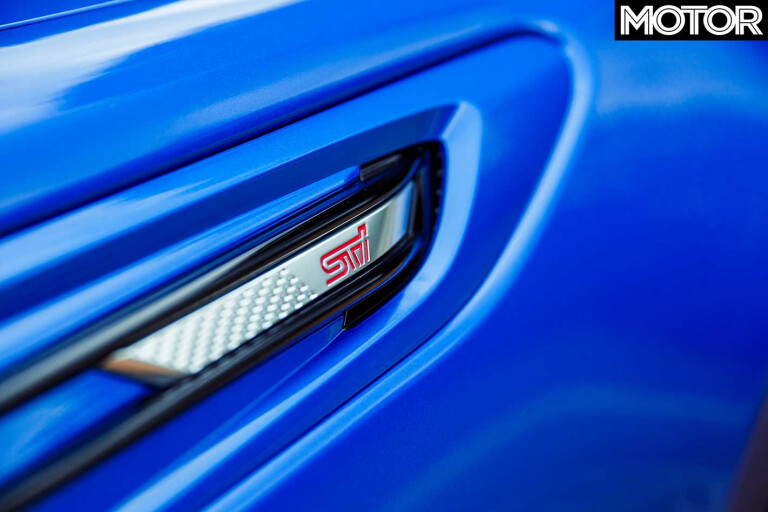
Finishing the package is Michelin’s new Pilot Sport 4 rubber on STI 18-inch alloys. And combined with myriad styling tweaks and accessories, the package pumps the BRZ’s standard price by $6000 to $39,900. Yet, it’s not the most expensive car here. That honour goes to the third car in this here test, the Mazda MX-5.
Almost cut from the same philosophical cloth as the Toyobaru twins – being lightweight, low power and low price – the MX-5 is obviously a radically different car, not least this RF version with its own folding hardtop roof.
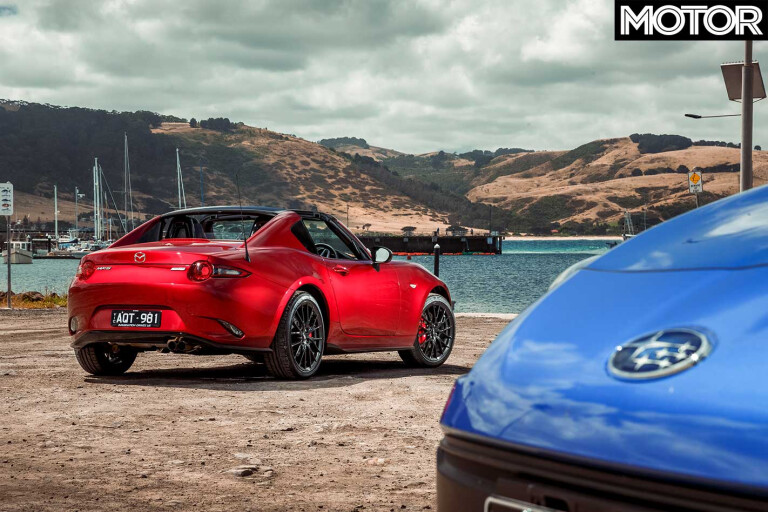
But wait, there’s more – we’ve nabbed one of 110 manual GT Limited Editions that have taken the Brembos and Bilstein dampers from American market MX-5 Club editions. It also adds trick adjustable Recaros and, strangely, a custom-made Seiko chronograph watch. Is this the best driver’s ND you can get? Perhaps.
It’s certainly the most expensive ND you can get. Unfortunately our fully loaded MX-5 isn’t as bargain-focused as our other two, and at $55,670 driveaway it brings back unpleasant memories of the NC days. As the ultimate MX-5 in specification and goodies, though, it deserves a shot against the other two at the title of ultimate cut-price lightweight rear-drive sports coupe.
For battle, we head to Victoria’s south-west Otway Ranges. The roads that wind their way through the seaside hills not only make for stunning photography, but their short and sharp corners favour handling over power. Perfect, then.

Our three protagonists certainly don’t raise eyebrows at the drag strip. (Again, we’re very sorry we don’t have performance numbers this issue – we’re working on getting them back.) The updated FA20 boxer punching away in the nose of our Toyota and Subaru reads like a gem on paper. It makes 152kW and 212Nm with bigger intake and exhaust runners, dual-fuel injection, variable-cam timing and variable valve-lift – all helping eke that meagre grunt from just 1998cc.
Scoff all you like, but it’s good enough to join the magic 100 horsepower-per-litre atmo club, with cars like the 911 GT3 and Audi R8. Although returning to reality with a thud, the boxer’s actual performance is nowhere near as bewitching.
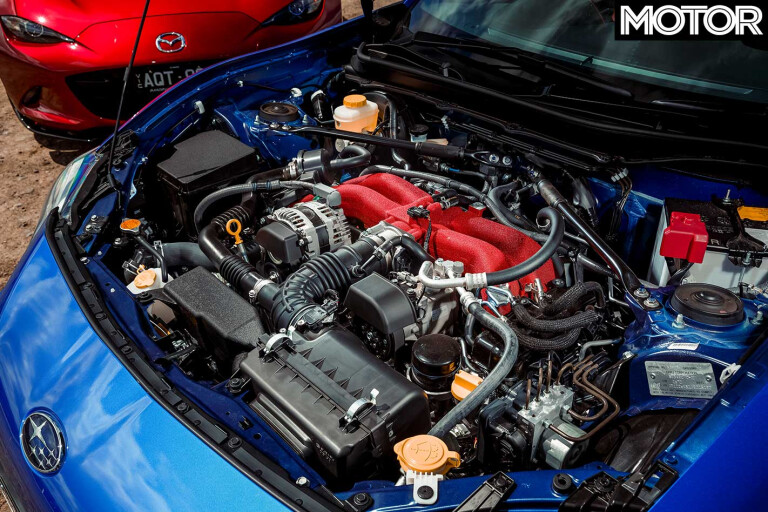
It might breathe through bigger pipes and feel enthusiastic when you first squeeze the throttle, but the urge disappears once revs pass 3000rpm. Acceleration picks up at 5500rpm as revs climb to a lofty power peak, but your foot spends forever on the firewall to get there. A little flat? Err, yep.
This robs the 86 and BRZ of meaningful in-gear thrust, and despite having to work their six-speed manual transmissions much harder as a result, it feels like a chore rather than an involving experience. Toyota or Subaru don’t seem to mind, clearly, as the torque hole is displayed in a real-time power graph on the LCD screen to the right of the rev gauge.
The MX-5 may pinch its undersquare inline-four from a Mazda3, rev to 6800rpm (versus 7400rpm), and produce 59kW per litre (versus 76kW), but its 2.0 litres feel much more muscular than the Subaru’s and Toyota’s.
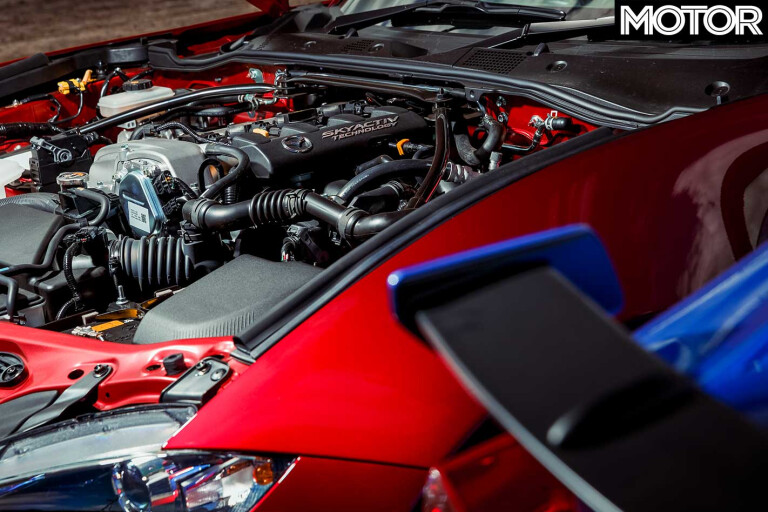
It certainly sounds better. Rather than the lumpy augmented intake noise heard in the 86 and BRZ cabin, you can almost hear the MX-5’s valves, lobes, and tappets gnashing together. Add the gruff blare from its tailpipes and each ascent to redline with the roof down sounds like driving through a bee swarm. The six-speed’s shift, too, is a real snickety sweetheart, whereas the 86 and BRZ’s longer shift can catch a bit when it’s cold.
While you’d need to run the 86 or BRZ downhill with a tailwind to dip into 6.0sec 0-100km/h runs or 14.0sec quarter miles, Mazda’s 2.0-litre soft-top has consistently delivered those times in previous performance testing. And the way our LE accelerates, even though it’s 60kg heavier, suggests it is every bit as fast. Each millimetre of throttle input changes the rate in which the scenery passes, and its torque builds in a flat, linear manner that makes every engine revolution count.

It’s a responsive unit, such that if you plant the throttle the Mazda’s bonnet will visibly and instantly lift, but you won’t want to be doing too much of that mid-corner as the GT LE is as sensitive to clumsy inputs as any other ND MX-5 we’ve driven. That’s even with the Bilstein dampers fitted to the LE, supposed to tame the extra softness built into the grand-tourer-designed RF.
There’s roll, squat and dive awaiting every one of your inputs. On the one hand, it makes you think so much about everything you do. You concentrate on brushing the brakes to tuck its front-end in, but then you need to come off them quickly to equalise its spread of grip. You also need to ease into the throttle to keep the nose down in case it pushes wide.
The MX-5’s 205mm Bridgestones can also only fulfil so many of your demands. And because the RF LE’s wheelbase is so short, the suspension so soft and the steering relatively slow, it drives with a twitchiness that makes every corner taken at more than eight tenths feel like a gamble with its grip limits.
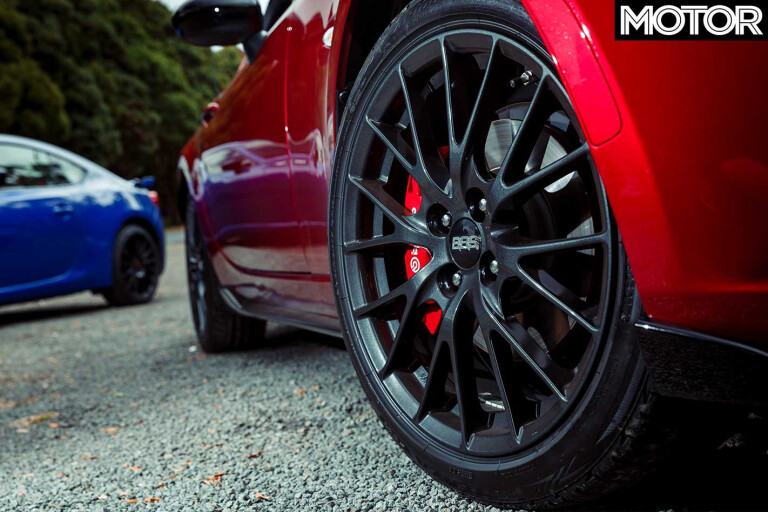
Following the Mazda in the Subaru is like watching someone try to run and balance an egg on a spoon at the same time. You notice the MX-5’s brake light flickering when you’re still into the throttle. And when you do use the Subaru’s brakes, they push back with more feel, depth, and power than the Mazda’s. They’re nothing like the soft items on the stock BRZ and the rear-end doesn’t come around like it’s on casters, either, if you brake too deep into a corner.
That’s mainly down its new Michelin Pilot Sport 4 tyres. They let the Subaru tear chunks out of the Mazda at each bend and raise its cornering limits to new dimensions. With the added grip you can get the BRZ up on its toes by turning in sharply. And because the tyres breakaway more progressively, you have more confidence to catch any twitches. Sharper, quicker, and more textured steering than the Mazda’s already brilliant system helps, too.
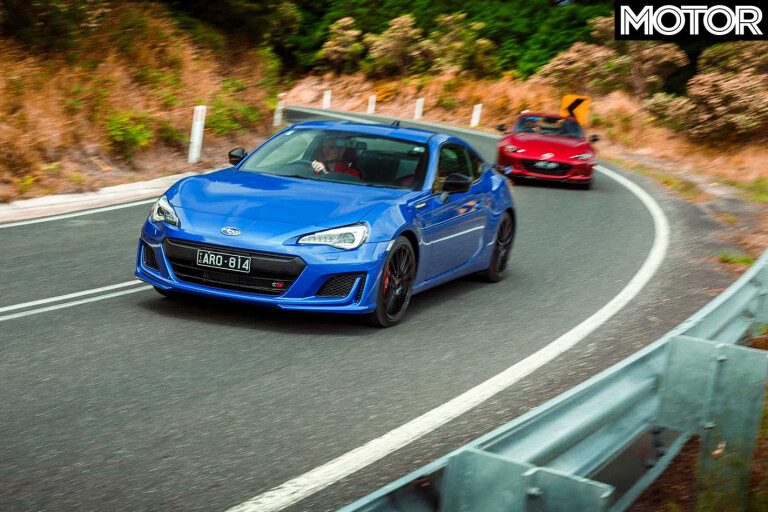
Even the Subaru’s computer systems have scored a leg-up from its new bits. Pock-marked roads trigger the Mazda’s ESP as its wheels drop in and out of holes, but the Subaru’s STI-tuned dampers control each wheel over bumps beautifully. The way it flows with roads means the BRZ’s dash rarely flickers with caution lights and its grip limits are now so stratospheric you don’t need to disarm the car’s stability system to get stuck in.
The Subaru BRZ tS is so capable, though, it’s like the athlete who’s competing one weight class too high. It has the moves, but lacks the punch to go with it. Sometimes you’ll pin the throttle through a string of corners for more than 10 seconds at a time. And you’ll often come out the other side of a flowing bend knowing the Subaru could carry more speed if it only had more power to play with.
Compounding the BRZ’s problem is the fact it no longer oversteers as easily. It used to induce grin-splitting slides with dismal outputs on hard springs and tyres, but you’ll now need a serious amount of commitment to get the Subaru sideways. Even on the racetrack.

Luckily, Toyota’s product planners have seen this coming and rather than transform the 86 into a high-grip monster with Porsche-like responses, it’s focused on retaining the original car’s playfulness. No doubt that’s helped by its Primacy HPs, because it’s surprising how hard you can push the 86 before it starts to loosen its hold.
Dial up your commitment to eight tenths on smooth flowing roads and it behaves almost identically to the BRZ tS, flowing from corner to corner with composure beyond a standard 86’s ability. It’s only when things start to tighten or you really push on that the tyres are exposed as a weak link in the dynamic chain. Suddenly the ABS bites a tyre into a corner or the throttle spins another coming out of it.
The 86’s balance, as well, will see its rear axle unstuck with more ease over mid-corner bumps. On bad roads, the Toyota’s thicker sidewalls also filter out the fine stuff while the Subaru’s 40-series tyres transmit more vibrations into the cabin.

Damper travel is short in both cars, and those STI lowering springs give the BRZ a slightly firmer bounce, but both packages find their bump stops with a soft thud rather than a crash. They have massaged more compliance into the stock car’s ride so that you can now tackle terrible roads without sacrificing feedback or control.
But the biggest indication that ride levels have improved in both cars, is that the prospect of a couple of hours on a highway in either, no longer makes you wince.
By contrast the MX-5 LE’s ride is fine on a highway, breathing with softer rises and falls, but ultimately the setup is stiff when you don’t want it to be. It’ll scuttle shake more than a regular MX-5 on poor surfaces. Luckily, its fantastic Recaros reclaim some day-to-day liveability. You’d happily rack up a couple hours more in them after a long day driving.
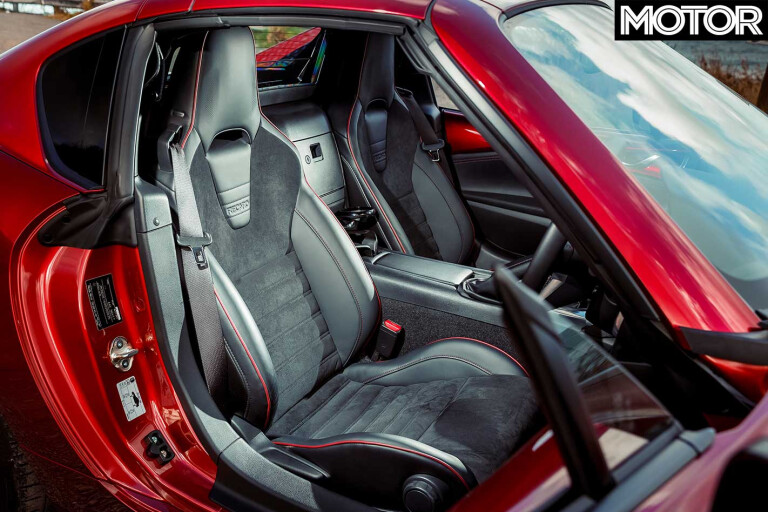
Once inside you’ll notice the RF has the most refined and evocative cabin design here, too, with the Bose stereo benefiting in particular from the hard-top’s added sound deadening. But space is cramped if you’re planning to bring anything more than your wallet. The ND MX-5 makes an 86 or BRZ feel roomy.
Those cars, too, aren’t going to win any awards for interior design but we appreciate their simplicity and straightforward ergonomics. The biggest news is Subaru has upgraded the BRZ’s infotainment with a 7.0-inch touchscreen sporting the latest ‘Starlink’ system across its range, putting graphics and functionality miles ahead of the Toyota’s ‘Link’ unit. Even Mazda’s MZD system can’t match the Sube’s for intuitiveness.
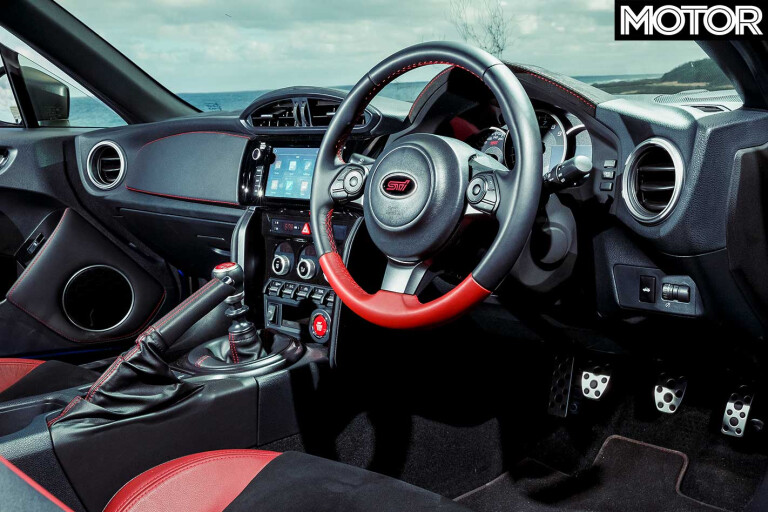
Ultimately, though, Mazda Australia’s intention to build the best MX-5 falls short in the RF GT LE. Bilstein suspension and Brembo brakes can’t extract any more grip from its carried-over tyres and it never really delivers a considered lift in performance. We understand big-spenders will magnetise to its all-out specification, but it’s hard to see the value in its $7K price hike when its bodykit and seats are the only products worth having over a non-LE variant.
Unless you must have Mazda’s slick six-speed manual and open-air driving experience, go for the BRZ tS or 86 Performance Pack. They might not be as thrifty as their donor cars at a smidge under $40K (before on-roads), but they offer a handling experience few could match at this price. If that’s what you prioritise, the Toyota will appeal to opposite-lock junkies while the Subaru is clearly aimed at track-day goers who thrive on more grip.
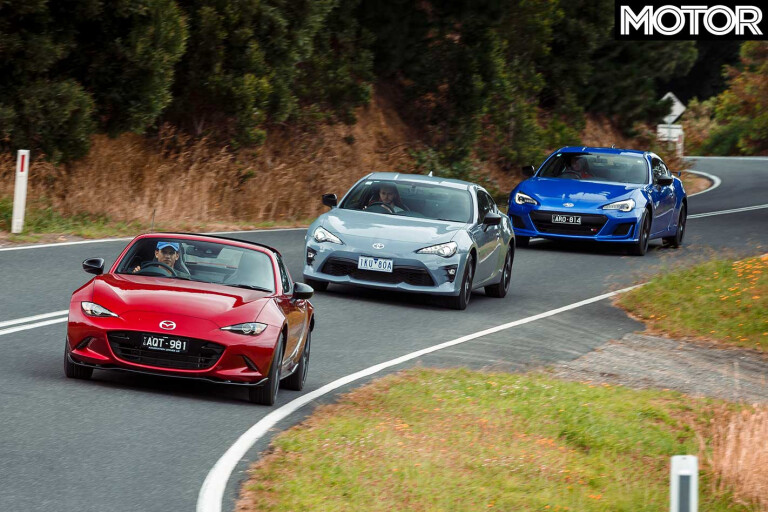
The decision’s easier to make on value when only $494 separates them. And while the BRZ’s chassis bracing make a negligible difference to its handling, the bigger wheels, specially tuned dampers, and stickier tyres certainly do. If it matters, the Subaru’s also easier on the eyes and its ‘Starlink’ infotainment system is infinitely better than the Toyota’s upgraded unit.
Toyota might have been wiser to offer the Performance Pack on its base GT to gain a $1000 advantage. Today, however, the BRZ tS unlocks the lurking potential in the BRZ’s handling platform to prove the fastest, most capable, and best value.
It’s a resounding confirmation to one of ‘those questions’, that yes, the BRZ does get better with more grip. Now, we’ll just wait to see whether Toyota will answer the other side of that coin when the next model launches in 2021.
Second Opinion: Scott Newman
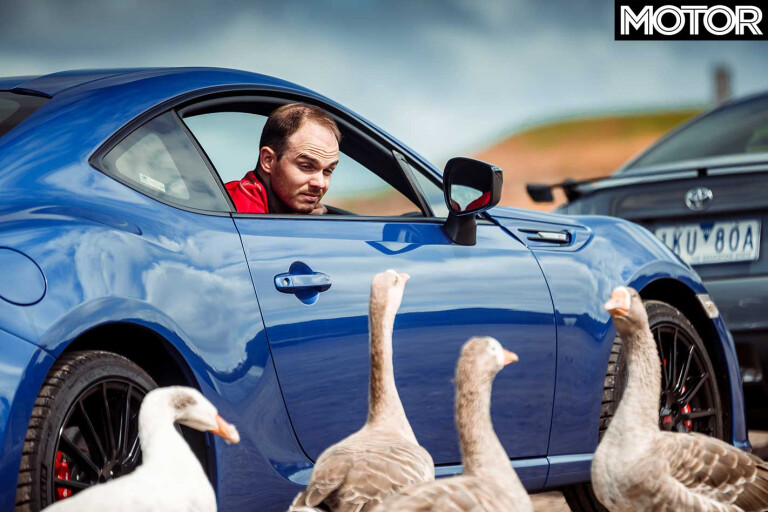
The MX-5 RF LE is a really appealing package. Maybe it’s just me, but I loved the colour of both exterior and interior, it’s a sweet powertrain combination and while the handling can be a bit wayward on the ragged edge, it’s certainly engaging. Overall, I really like... I’m sorry, it costs how much?
Toyota’s taken all the good bits from its garishly orange Limited Edition and offered them for a much lower price on this Performance Pack. If you’re a track-day devotee the upgrades are good value, but on the road the Michelin Primacy eco-tyres don’t offer enough grip to really exploit the chassis improvements. If you buy an 86 PP, invest in a better set of tyres.
Or just buy a BRZ tS. The latest-gen Michelin Pilot Sport 4 rubber arguably gives the Subaru too much grip, as it will no longer shimmy around at road speeds like the standard car. On the flip side, the extra purchase allows you to extract every ounce from the BRZ chassis – put simply, you can drive the ring off the tS. I can’t wait to drive it on track at Bang For Your Bucks.
The Subaru is the most well-rounded package here, but with a low-boost turbo kit it has the potential to be something truly magnificent.
Fast Facts
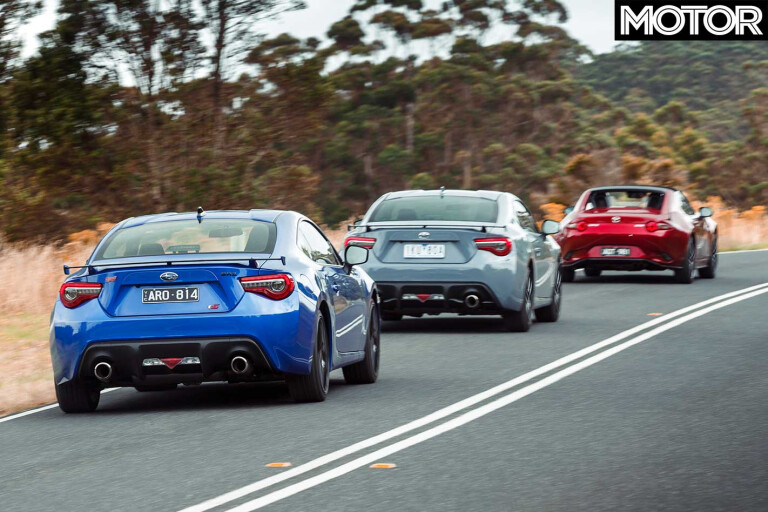
| 2018 Subaru BRZ tS | 2018 Toyota 86 GTS Performance Pack | 2018 Mazda MX-5 RF Limited Edition | |
| BODY | 2-door, 4-seat coupe | 2-door, 4-seat coupe | 2-door, 2-seat roadster |
| DRIVE | rear-wheel | rear-wheel | rear-wheel |
| ENGINE | 1998cc boxer-4, DOHC, 16v | 1998cc boxer-4, DOHC, 16v | 1998cc inline-4, DOHC, 16v |
| BORE/STROKE | 86 x 86mm | 86 x 86mm | 83.5 x 91.2mm |
| COMPRESSION | 12.5:1 | 12.5:1 | 13.0:1 |
| POWER | 152kW @ 7000rpm | 152kW @ 7000rpm | 118kW @ 6400rpm |
| TORQUE | 212Nm @ 6400-6800rpm | 212Nm @ 6400-6800rpm | 200Nm @ 4600rpm |
| WEIGHT | 1295kg | 1258kg | 1091kg |
| POWER/WEIGHT | 117kW/tonne | 121kW/tonne | 108kW/tonne |
| TRANSMISSION | 6-speed manual | 6-speed manual | 6-speed manual |
| SUSPENSION (front) | struts, dampers, anti-roll bar | struts, dampers, anti-roll bar | struts, dampers, anti-roll bar |
| SUSPENSION (rear) | A-arms, dampers, anti-roll bar | A-arms, dampers, anti-roll bar | multi-links, dampers, anti-roll bar |
| L/W/H | 4240/1775/1320mm | 4240/1775/1320mm | 3915/1735/1235mm |
| WHEELBASE | 2570mm | 2570mm | 2310mm |
| TRACKS | 1520/1540mm (f/r) | 1520/1540mm (f/r) | 1495/1505mm (f/r) |
| STEERING | electrically-assisted rack-and-pinion | electrically-assisted rack-and-pinion | electrically-assisted rack-and-pinion |
| BRAKES (front) | 326mm ventilated discs, 4-piston calipers | 326mm ventilated discs, 4-piston calipers | 280mm ventilated discs, 4-piston calipers |
| BRAKES (rear) | 316mm ventilated discs, 2-piston calipers | 316mm ventilated discs, 2-piston calipers | 280mm ventilated discs, single-piston calipers |
| WHEELS | 18.0 x 7.5-inch (f/r) | 17.0 x 8.0-inch (f/r) | 17.0 x 7.0-inch (f/r) |
| TYRE SIZES | 215/40 R18 85Y (f/r) | 215/45 R17 87W (f/r) | 205/45 R17 84W (f/r) |
| TYRE | Michelin Pilot Sport 4 | Michelin Primacy HP | Bridgestone S001 |
| PRICE | $39,894 | $39,400 | $55,670 (driveaway) |
| PROS | Grip; brakes; point; infotainment system | Involvement; ride; steering | Brilliant seats; engine sound; looks |
| CONS | Lack of power; does it now have too much grip? | Infotainment system; lack of power | Unresolved handling; questionable value |
| RATING | 4.5 out of 5 stars | 4 out of 5 stars | 3.5 out of 5 stars |

COMMENTS